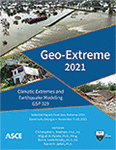Seismic Slope Displacements: Insights from Traditional Regression and Artificial Neural Networks
Publication: Geo-Extreme 2021
ABSTRACT
Generic predictive models of earthquake-induced slope displacement are developed through classical regression analysis and artificial neural networks (ANNs). The maximum displacement on the slope surface at the end of shaking was computed by finite element simulations of 49 slope models subjected to 1,051 earthquake motions. Predictive models of seismic displacement are developed that characterizes the slope in terms of its yield acceleration (ky), the natural period of slope (Tslope), and the relative thickness of the slip surface to the height of the slope (Hratio), and characterizes ground shaking in terms of different ground-motion intensity measures. Across five intensity measures and 10 combinations of intensity measures, peak ground velocity (PGV) is found to be the most efficient and proficient parameter for the displacement prediction, leading to significantly small aleatory variability that is similar to the values derived from the use of multiple intensity measures. The models derived from ANN are similar to those developed from classical regression, although with slightly smaller variability and they did not require development of a complex functional form. These results indicate that ANN may be a viable alternative to classical regression for seismic slope stability models.
Get full access to this article
View all available purchase options and get full access to this chapter.
REFERENCES
Arias, A. (1970). A measure of earthquake intensity., MIT Press, Cambridge Massachusetts.
Athanasopoulos-Zekkos, A., Pence, H., and Lobbestael, A. (2016). “Ground Motion Selection for Seismic Slope Displacement Evaluation of Earthen Levees”, Earthquake Spectra, Earthquake Engineering Research Institute, doi: https://doi.org/10.1193/062513EQS169M, February 2016, Vol. 32, No. 1, pp. 217–237.
Bray, J. D., and Travasarou, T. (2007). “Simplified Procedure for Estimating Earthquake-Induced Deviatoric Slope Displacements”, J. Geotech. and Geoenvir. Engrg., Volume 133, Issue 4, 381–392.
Bray, J. D., Rathje, E. M., Augello, A. J., and Merry, S. M. (1998). “Simplified Seismic Design Procedure for Lined Solid-Waste Landfills”, Geosynthetics International, 5(1-2), pp. 203–235.
Cho, Y., and Rathje, E. (2020). “Simulations of Seismic Displacement of a Clay Slope using LS-Dyna” DesignSafe-CI. https://doi.org/10.17603/ds2-4j71-7603, https://doi.org/10.17603/ds2-bb8s-t545.
Cornell, C. A., and Luco, N. (2001). Ground motion intensity measures for structural performance assessment at near-fault sites. Proc., U.S.-Japan Joint Workshop and Third Grantees Meeting, U.S.-Japan Cooperative Research on Urban EQ. Disaster Mitigation, Seattle.
Cybenko, G. (1989). Approximation by superpositions of a sigmoidal function, Mathematics of Control, Signals, and Systems, 2(4): 303–314.
Fotopoulou, S. D., and Pitilakis, K. D. (2015). Predictive relationships for seismically induced slop displacements using numerical analysis results. Bulletin of Earthquake Engineering, 13: 3207–3238: doi: https://doi.org/10.1007/s10518-015-9768-4.
Hale, C. D. (2019). A transfer function model for deformation hazard analysis of earthen dams, Ph.D. dissertation, University of California, Berkeley.
LSTC. (2015). LS-DYNA keyword user’s manual version 971 R8. Livermore Software Technology Corporation, Livermore, California.
Makdisi, F. I., and Seed, H. B. (1978). Simplified procedure for estimating dam and embankment earthquake induced deformations. Journal of Geotechnical Engineering Division., 104(GT7), 849–867.
Padgett, J. E., Nielson, B. G., and DesRoches, R. (2008). Selection of optimal intensity measures in probabilistic sesmic demand models of highway bridge portfolios 37: 711–725 doi: https://doi.org/10.1002/eqe.782.
Rathje, E. M., Dawson, C., Padgett, J. E., Pinelli, J. P., Stanzione, D., Adair, A., Arduino, P., Brandenberg, S. J., Cockerill, T., Dey, C., Esteva, M., Haan, F. L., Jr., Hanlon, M., Kareem, A., Lowes, L., Mock, S., and Mosqueda, G. (2017), DesignSafe: A new cyberinfrastructure for natural hazards engineering. ASCE Natural Hazards Review, doi: https://doi.org/10.1061/(ASCE)NH.1527-6996.0000246.
Rathje, E. M., and Bray, J. D. (1999), An examination of simplified earthquake-induced displacement procedures for earth structures. Canadian Geotechnical Journal, 36(1): 72–87.
Rathje, E. M., and Bray, J. D. (2000). Nonlinear coupled seismic sliding analysis of earth structures. Journal of Geotechnical and Geoenvironmental Engineering, 126(11): 1002–1014.
Rathje, E. M., Faraj, F., Russell, S., and Bray, J. D. (2004). “Empirical Relationships for Frequency Content Parameters of Earthquake Ground Motions,” Earthquake Spectra, Earthquake Engineering Research Institute, 20(1), pp. 119–144.
Reed, J. W., and Kassawara R. P. (1990). A criterion for determining exceedance of the operating basis earthquake. Nucl. Eng. Des., 123: 387–396.
Saygili, G., and Rathje, E. M. (2008). Empirical predictive models for earthquake-induced sliding displacements of slopes. Journal of Geotechnical and Geoenvironmental Engineering, 134(6): 790–803.
Information & Authors
Information
Published In
Copyright
© 2021 American Society of Civil Engineers.
History
Published online: Nov 4, 2021
Authors
Metrics & Citations
Metrics
Citations
Download citation
If you have the appropriate software installed, you can download article citation data to the citation manager of your choice. Simply select your manager software from the list below and click Download.
